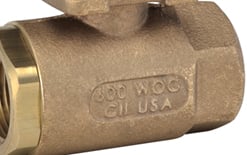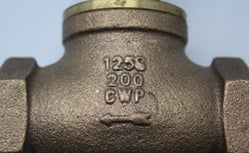What are Valve Pressure Ratings?
The sizing and selection of Control Valves have considerations beyond the flow capacity (Cv) relating to conditions they will encounter in operation. These are divided into two main ratings: Body Pressure and Close-Off pressure.
Body Pressure Rating is a body and stem (shell) static rating, the amount of total pressure that the body and stem can contain without leaking. The body static pressure requirements for chilled and hot water valves are generally determined by the sum of the water column, fill, and pump pressures that the valve will experience. The pressure rating will be expressed in various ways depending on the valve manufacturer and type.
Common Ratings

WOG (Water, Oil, Gas) is a non-shock pressure rating for valves at ambient temperature. Oil refers to a free-flowing liquid containing higher viscosity than water and lubricating characteristics. Gas refers to a vaporized liquid, such as steam, and does not cover combustible gases. These will be expressed in PSI- 600 WOG equals 600 psi.
CWP (Cold Working Pressure) defines the maximum pressure rating for valves between -20F – 100F. These will be expressed in PSI- 200 CWP equals 200 psi.
PN (Pressure Nominal) is indicated in bar; for example, PN25 is 25 bar. 1 bar equals 14.5 psi. Sometimes manufacturers will include the psi rating as well.
Flanged or lug-style valves are categorized by ANSI flange classes covered under ASME B16 standards. Class 125 and 250 cover cast iron valves and flanges (B16.1). Class 150 and 300 covers ductile iron (B16.42), steel and stainless steel (B16.5). These ANSI classes have temperature pressure charts that correlate to the flange and/or valve ratings. Valves may indicate specific body pressure ratings exclusive of the flange rating.
Close-Off is the maximum differential across the ball or disc that the valve can hold against the rated seat leakage. The rated close-off pressure considers the entire assembly of the valve, actuator, and linkage. This pressure must be higher than the maximum differential pressure (Dp) the valve will be subjected to in the installation. The calculation is determined by the maximum pump differential for a two-way application. Valve close-off rating and maximum differential pressure rating may differ due to valve trim limitations. For example, a CCV may have a 200 psi close-off rating but a maximum Dp rating of 30 psi.



